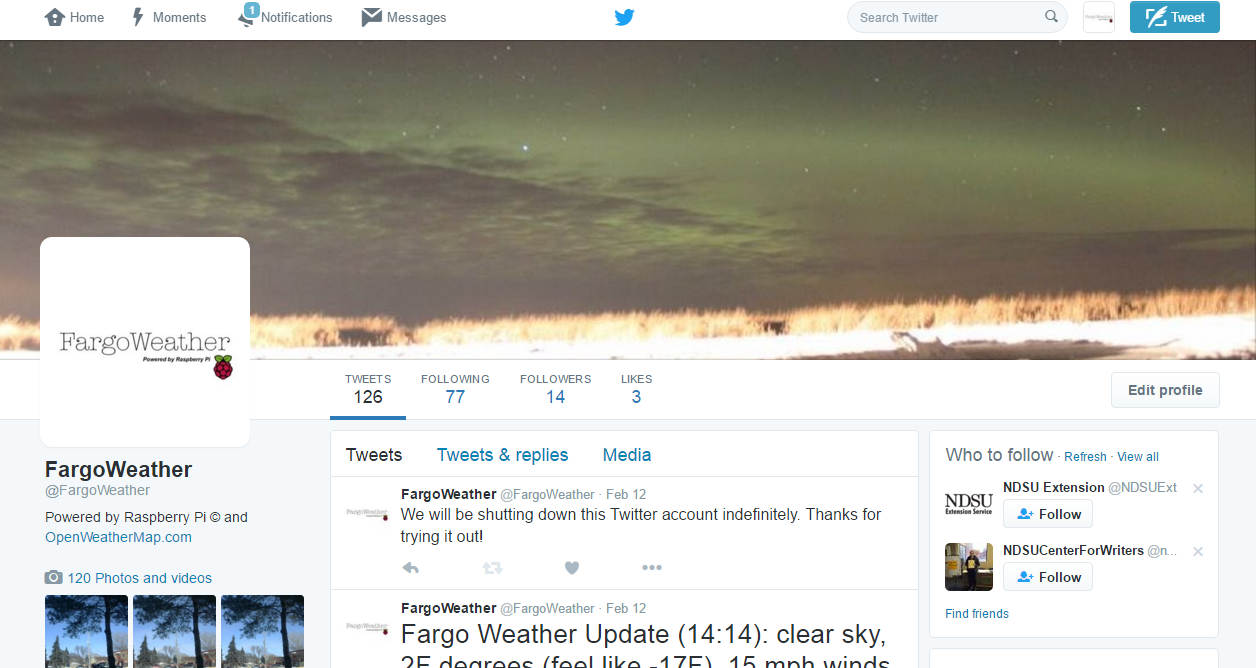
Home | About | Astrophotography | Books | Blog | Cybersecurity | Movies | Projects | Resume | Space | Video Games | War Museum | Wikipedia

Pictures and description coming soon.


After receiving my Raspberry Pi 2 Model B for my birthday, I quickly dived into learning everything I could about it. I knew Python was one of the central scripting langauges used in the Pi, and so I wanted my first project to involve Python. I had the idea for FargoWeather after reading online about Tweeting from the Pi. I found an old webcam in my room, and wrote a script in Python that would use a free weather API online (OpenWeatherMap.com) and the Twitter Application API to tweet real-time weather details from Fargo. Tweets included a general description, temperature, feel-like temperature (calculated using a formula), wind speed, humidity, and a photo taken from my webcam pointing out my window! I was super proud of the first tweets and what my Pi was capable of. The Twitter account is active often, and I would soon like to measure the temperature myself using a cheap temperature sensor. Check it out here.


While working as an Information Technology intern at the United States Department Agriculture, I began working on a small application for our end users during some of the free time I had. The idea was to streamline our help desk service and allow users to quickly and easily gather information about their computer that might assist them, as well as our help desk, in troubleshooting issues. The program was written in Java using NetBeans and features an all-in-one GUI that allows users to quickly access common functions such as their computer name, IPv4 address, Java version, and more. One of the most notable functions of the application is the file finder system I wrote entirely from scratch that allows someone to quickly search for a file using specific keywords of the file name or the extension of the file type. In addition, users can search in one of the default directories or specify the directory they would like to search in. I'm pretty proud of it.
Although a work order system was something we already had, I developed one to test my skills and just in case our work order system ever went offline suddenly. The work order system is nothing fancy, it is just a system of text files that are read and written by the program to keep track of requests, who submits them, who closes them, and more. One of the coolest aspects of the system is that it allows someone answering the ticket to write a comment on the ticket request, perhaps if they required more details about the request. The work orders are shared on the network drive, so unfortunately if the network shares are down, the work order system is down. The work order system is managed through the Admin console of the application.




Also while working at the United States Department of Agriculture, there came a time when we were to put forward a proposal for a new cabling project and possible remodel of our server rooms. Throughout this process, I began modeling exact replicas to scale of our server rooms in Google's 3D modeling program SketchUp. I thoroughly enjoyed working on this project, as I find Google SketchUp to be a brilliant program with extensive capabilites in design and planning. I dived as deep as rendering individual server components such as our racks and switches so they can be replicated in future models at the click of a button. Given the chance to work with SketchUp again, I wouldn't hesitate. Perhaps one day I will design my dream home.